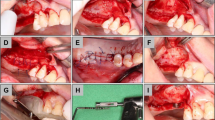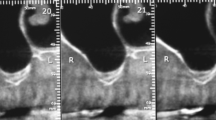Abstract
The aim of the study was to analyze the histologic and ultrastructural changes after maxillary sinus augmentation with simultaneous implant placement using engineered bone graft material. In this study, calcium phosphate cement (CPC) scaffolds combined with goat bone marrow stromal cells (BMSCs) were used to fill goat sinus floor space after maxillary sinus floor elevation with simultaneous implant placement comparing with those not filled any grafted materials and used as controls. After a healing period of 3 months, the goat maxillary sinus membrane was examined using light microscopy and scanning electronic microscopy. The results showed that the connective tissue thickness and the epithelium thickness of mucosa were not statistically significant difference between two groups. The tissue engineered bone complex might be an ideal graft for the sinus floor elevation and have no influence on the sinus membrane under the histological and ultrastructural observation.
Similar content being viewed by others
References
Del F M, Testori T, Francetti L, et al. Systematic review of survival rates for implants placed in grafted maxillary sinus [J]. International Journal of Periodontics & Restorative Dentistry, 2004, 24(6): 565–577.
Sun X J, Zhang Z Y, Wang S Y, et al. Maxillary sinus floor elevation using tissue-engineered bone complex with OsteoBoneTM and BMSCs in rabbits [J]. Clinical Oral Implants Research, 2008, 19(8): 804–813.
Ueda M, Yamada Y, Ozawa R, et al. Clinical case reports of injectable tissue-engineered bone for alveolar augmentation with simultaneous implant placement [J]. The International Journal of Periodontics & Restorative Dentistry, 2005, 25(2): 129–137.
Wiltfang J, Schultze M S, Merten H A, et al. Endoscopic and ultrasonographic elevation of the maxillary sinus after combined sinus floor augmentation and implant insertion [J]. Oral Surgery, Oral Medicine, Oral Pathology, Oral Radiology & Endodontics, 2000, 89(3): 288–291.
Schmelzeisen R, Schimming R, Sittinger M. Making bone: Implant insertion into tissue-engineering bone for maxillary sinus floor augmentation [J]. Journal of Cranio-Maxillo-Facial Surgery, 2003, 31(1): 34–39.
Zou D, Guo L, Lu J, et al. Anatomic and histological analysis in a goat model used for maxillary sinus floor augmentation with simultaneous implant placement [J]. Clinical Oral Implants Research, 2010, 21(1): 65–70.
Sul S H, Choi B H, Li J, et al. Histologic changes in the maxillary sinus membrane after sinus membrane elevation and the simultaneous insertion of dental implants without the use of grafting materials [J]. Oral Surgery, Oral Medicine, Oral Pathology, Oral Radiology & Endodontics, 2008, 105(4): 1–5.
Estaca E, Cabezas J, Uson J, et al. Maxiilary sinus-floor elevation: An animal model [J]. Clinical Oral Implants Research, 2008, 19(10): 1044–1048.
Wilma T, Anselmo L, Maria D S F, et al. Histological evaluation of maxillary sinus mucosa after functional endoscopic sinus surgery [J]. American Journal of Rhinology, 2007, 21(6): 719–724.
Wagenmann M, Naclerio R M. Anatomic and physiologic considerations in sinusitis [J]. Journal of Allergy and Clinical Immunology, 1992, 90(2–3): 419–423.
Hernandez A F, Torradeflot M M, Marti C. Prevalence and management of Schneiderian membrane perforations during sinus-lift procedures [J]. Clinical Oral Implants Research, 2008, 19(1): 91–98.
Ribeiro R R F, Lindh C, Rohlin M. Efficacy of clinical methods to assess jawbone tissue prior to and during endosseous dental implant placement: A systematic literature review [J]. The International Journal of Oral & Maxillofacial Implants, 2007, 22(2): 289–300.
Yuan H, Li Y, Bruijn J D, et al. Tissue responses of calcium phosphate cement: A study in dogs [J]. Biomaterials, 2000, 21(12): 1283–1290.
Sato I, Akizuki T, Oda S, et al. Histological evelation of alveolar ridge augmentation using injectable calcium phosphate bone cement in dogs [J]. Journal of Oral Rehabilitation, 2009, 36(10): 762–769.
Zhu L, Liu W, Cui L. Tissue-engineered bone repair of goat-femur defects with osteogenically induced bone marrow stromal cells [J]. Tissue Engineering, 2006, 12(3): 423–433.
Author information
Authors and Affiliations
Corresponding author
Additional information
Foundation item: the Natural Science Foundation of Science and Technology Commission of Shanghai Municipality (Nos. 09JC1411700 and S30206) and the Natural Science Foundation of Shanghai Jiaotong University School of Medicine (No. 09XJ21030)
Rights and permissions
About this article
Cite this article
Lu, JY., Zhao, W., Zhu, H. et al. Histologic changes in the sinus membrane after maxillary sinus augmentation with simultaneous implant placement using engineered bone graft material. J. Shanghai Jiaotong Univ. (Sci.) 16, 380–384 (2011). https://doi.org/10.1007/s12204-011-1166-8
Received:
Published:
Issue Date:
DOI: https://doi.org/10.1007/s12204-011-1166-8
Key words
- tissue engineering
- bone marrow stromal cells (BMSCs)
- calcium phosphate cement (CPC)
- maxillary sinus floor elevation
- simultaneous implant
- sinus membrane




